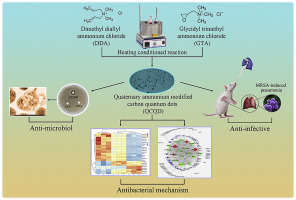Our official English website, www.x-mol.net, welcomes your
feedback! (Note: you will need to create a separate account there.)
Quaternary ammonium modified carbon quantum dots as an antimicrobial agent against gram-positive bacteria for the treatment of MRSA-infected pneumonia in mice
Carbon ( IF 10.5 ) Pub Date : 2020-08-01 , DOI: 10.1016/j.carbon.2020.03.009 Chengfei Zhao , Lina Wu , Xuewen Wang , Shaohuang Weng , Zhipeng Ruan , Qicai Liu , Liqing Lin , Xinhua Lin
Carbon ( IF 10.5 ) Pub Date : 2020-08-01 , DOI: 10.1016/j.carbon.2020.03.009 Chengfei Zhao , Lina Wu , Xuewen Wang , Shaohuang Weng , Zhipeng Ruan , Qicai Liu , Liqing Lin , Xinhua Lin

|
Abstract In this work, quaternary ammonium carbon quantum dots (QCQD) was successfully synthesized with 2,3-epoxypropyltrimethylammonium chloride and diallyldimethylammonium chloride by a simple green “one-pot” method. QCQD was demonstrated to have satisfactory antibacterial activity against gram-positive bacteria, including Staphylococcus aureus, methicillin-resistant Staphylococcus aureus (MRSA), Staphylococcus epidermidis, Listera monocytogenes and Enterococcus faecalis. QCQD was used to treat MRSA-infected pneumonia in mice, and could promote the regression of pulmonary inflammation in lung of mice. In vivo and in vitro toxicity tests also confirmed that QCQD had acceptable biocompatibility. There is no doubt that all the experimental results confirmed that QCQD is a promising antimicrobial agent for treating infections of gram-positive bacteria. The antibacterial mechanism of QCQD was analyzed and confirmed by the quantitative proteomics based tandem mass tags, revealing that QCQD might interfere with the protein translation, posttranslational modification and protein turnover in bacterial cells by mainly acting on ribosomes and upregulating RNA degradation related proteins. The application of proteomics extended the research on antibacterial mechanism from single target to protein network and realized the research and analysis on multiple targets of bacteria treated by QCQD, providing a new idea and strategy for the development of efficient bactericidal weapon against drug-resistant bacteria.
中文翻译:

季铵修饰的碳量子点作为革兰氏阳性菌的抗菌剂用于治疗小鼠 MRSA 感染的肺炎
摘要 本工作以2,3-环氧丙基三甲基氯化铵和二烯丙基二甲基氯化铵为原料,采用简单的绿色“一锅法”合成了季铵碳量子点(QCQD)。QCQD 被证明对革兰氏阳性菌具有令人满意的抗菌活性,包括金黄色葡萄球菌、耐甲氧西林金黄色葡萄球菌 (MRSA)、表皮葡萄球菌、单核细胞增生李斯特菌和粪肠球菌。QCQD用于治疗小鼠MRSA感染的肺炎,可促进小鼠肺部炎症的消退。体内和体外毒性试验也证实 QCQD 具有可接受的生物相容性。毫无疑问,所有的实验结果都证实了 QCQD 是治疗革兰氏阳性菌感染的一种很有前途的抗菌剂。通过基于定量蛋白质组学的串联质量标签分析和证实了QCQD的抗菌机制,揭示QCQD可能通过主要作用于核糖体和上调RNA降解相关蛋白来干扰细菌细胞中的蛋白质翻译、翻译后修饰和蛋白质周转。蛋白质组学的应用将抗菌机理的研究从单一靶点扩展到蛋白质网络,实现了对QCQD处理细菌的多个靶点的研究和分析,为开发针对耐药菌的高效杀菌武器提供了新的思路和策略。通过基于定量蛋白质组学的串联质量标签分析和证实了QCQD的抗菌机制,揭示QCQD可能通过主要作用于核糖体和上调RNA降解相关蛋白来干扰细菌细胞中的蛋白质翻译、翻译后修饰和蛋白质周转。蛋白质组学的应用将抗菌机理研究从单一靶点扩展到蛋白质网络,实现了对QCQD处理细菌的多个靶点的研究和分析,为开发针对耐药菌的高效杀菌武器提供了新的思路和策略。通过基于定量蛋白质组学的串联质量标签分析和证实了QCQD的抗菌机制,揭示QCQD可能通过主要作用于核糖体和上调RNA降解相关蛋白来干扰细菌细胞中的蛋白质翻译、翻译后修饰和蛋白质周转。蛋白质组学的应用将抗菌机理研究从单一靶点扩展到蛋白质网络,实现了对QCQD处理细菌的多个靶点的研究和分析,为开发针对耐药菌的高效杀菌武器提供了新的思路和策略。通过主要作用于核糖体和上调 RNA 降解相关蛋白,从而在细菌细胞中进行翻译后修饰和蛋白质周转。蛋白质组学的应用将抗菌机理研究从单一靶点扩展到蛋白质网络,实现了对QCQD处理细菌的多个靶点的研究和分析,为开发针对耐药菌的高效杀菌武器提供了新的思路和策略。通过主要作用于核糖体和上调 RNA 降解相关蛋白,从而在细菌细胞中进行翻译后修饰和蛋白质周转。蛋白质组学的应用将抗菌机理研究从单一靶点扩展到蛋白质网络,实现了对QCQD处理细菌的多个靶点的研究和分析,为开发针对耐药菌的高效杀菌武器提供了新的思路和策略。
更新日期:2020-08-01
中文翻译:

季铵修饰的碳量子点作为革兰氏阳性菌的抗菌剂用于治疗小鼠 MRSA 感染的肺炎
摘要 本工作以2,3-环氧丙基三甲基氯化铵和二烯丙基二甲基氯化铵为原料,采用简单的绿色“一锅法”合成了季铵碳量子点(QCQD)。QCQD 被证明对革兰氏阳性菌具有令人满意的抗菌活性,包括金黄色葡萄球菌、耐甲氧西林金黄色葡萄球菌 (MRSA)、表皮葡萄球菌、单核细胞增生李斯特菌和粪肠球菌。QCQD用于治疗小鼠MRSA感染的肺炎,可促进小鼠肺部炎症的消退。体内和体外毒性试验也证实 QCQD 具有可接受的生物相容性。毫无疑问,所有的实验结果都证实了 QCQD 是治疗革兰氏阳性菌感染的一种很有前途的抗菌剂。通过基于定量蛋白质组学的串联质量标签分析和证实了QCQD的抗菌机制,揭示QCQD可能通过主要作用于核糖体和上调RNA降解相关蛋白来干扰细菌细胞中的蛋白质翻译、翻译后修饰和蛋白质周转。蛋白质组学的应用将抗菌机理的研究从单一靶点扩展到蛋白质网络,实现了对QCQD处理细菌的多个靶点的研究和分析,为开发针对耐药菌的高效杀菌武器提供了新的思路和策略。通过基于定量蛋白质组学的串联质量标签分析和证实了QCQD的抗菌机制,揭示QCQD可能通过主要作用于核糖体和上调RNA降解相关蛋白来干扰细菌细胞中的蛋白质翻译、翻译后修饰和蛋白质周转。蛋白质组学的应用将抗菌机理研究从单一靶点扩展到蛋白质网络,实现了对QCQD处理细菌的多个靶点的研究和分析,为开发针对耐药菌的高效杀菌武器提供了新的思路和策略。通过基于定量蛋白质组学的串联质量标签分析和证实了QCQD的抗菌机制,揭示QCQD可能通过主要作用于核糖体和上调RNA降解相关蛋白来干扰细菌细胞中的蛋白质翻译、翻译后修饰和蛋白质周转。蛋白质组学的应用将抗菌机理研究从单一靶点扩展到蛋白质网络,实现了对QCQD处理细菌的多个靶点的研究和分析,为开发针对耐药菌的高效杀菌武器提供了新的思路和策略。通过主要作用于核糖体和上调 RNA 降解相关蛋白,从而在细菌细胞中进行翻译后修饰和蛋白质周转。蛋白质组学的应用将抗菌机理研究从单一靶点扩展到蛋白质网络,实现了对QCQD处理细菌的多个靶点的研究和分析,为开发针对耐药菌的高效杀菌武器提供了新的思路和策略。通过主要作用于核糖体和上调 RNA 降解相关蛋白,从而在细菌细胞中进行翻译后修饰和蛋白质周转。蛋白质组学的应用将抗菌机理研究从单一靶点扩展到蛋白质网络,实现了对QCQD处理细菌的多个靶点的研究和分析,为开发针对耐药菌的高效杀菌武器提供了新的思路和策略。







































 京公网安备 11010802027423号
京公网安备 11010802027423号